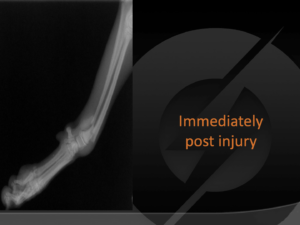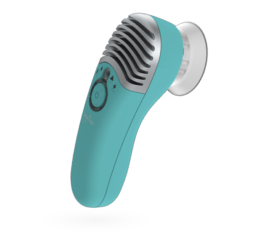Case Study: Successful Treatment of Distal Radial Fracture in an Italian Greyhound using Laser Therapy
Abstract: This case study presents the successful treatment of a distal radial fracture in an Italian Greyhound using light therapy. Distal radial fractures, particularly in the front leg near the carpus, are known for their slow healing due to limited blood supply. However, by incorporating light therapy after surgical repair, significant improvements were observed within a short period. The dog achieved complete healing, regained weight-bearing ability, and resumed normal activities within 6-8 weeks.
- Introduction: Italian Greyhounds are small and delicate dogs that can be prone to fractures, including distal radial fractures. These fractures, occurring near the carpus (wrist), often present challenges in healing due to restricted blood flow to the area. This case study aims to demonstrate the efficacy of light therapy in promoting the healing of a distal radial fracture in an Italian Greyhound.
- Case Presentation: A 1-year-old male Italian Greyhound presented with a distal radial fracture in the front leg. The fracture was diagnosed through physical examination and confirmed by radiographic imaging. Due to the location of the fracture and the breed’s known healing challenges, surgical intervention was recommended to achieve proper alignment and stability.
- Treatment: The dog underwent surgical repair of the distal radial fracture, which involved the application of a bone plate and screws to stabilize the fracture site. Post-surgery, the dog was prescribed strict rest and limited mobility to prevent further damage and ensure proper healing.
In addition to the standard post-operative care, the veterinary team implemented light therapy as an adjunctive treatment to expedite the healing process. Low-level laser therapy (LLLT) was administered using a handheld laser device. The light therapy sessions were conducted every other day for a total of 12 sessions.
- Treatment Outcomes: Within two weeks of incorporating light therapy into the treatment plan, follow-up X-rays revealed evidence of bone healing. The fracture site showed signs of callus formation, indicating the initiation of the healing process. The dog exhibited minimal discomfort and was gradually encouraged to bear weight on the affected limb.
Over the subsequent weeks, the Italian Greyhound demonstrated steady progress. The dog gradually increased weight-bearing on the front leg, and by the sixth week, was fully weight-bearing and walking comfortably. The canine’s activity levels were monitored and gradually increased under veterinary guidance. By the eighth week, the dog had made a complete recovery, displaying normal mobility, and actively engaging in play and exercise.
- Discussion: Distal radial fractures in Italian Greyhounds pose a significant challenge due to their slow healing nature, often leading to suboptimal outcomes. The incorporation of light therapy into the treatment plan in this case study showed promising results. Light therapy, specifically LLLT, is known to promote tissue healing and reduce inflammation by stimulating cellular metabolism and enhancing blood flow. These effects likely played a vital role in accelerating the healing process in the fractured radius of the Italian Greyhound.
The early evidence of bone healing observed within two weeks of light therapy suggests that it helped overcome the limited blood supply to the area, which is a primary factor contributing to slow healing. By promoting cell repair and reducing inflammation, light therapy may have expedited callus formation and subsequent bone remodeling, leading to the dog’s successful recovery.
- Conclusion: Incorporating light therapy, specifically LLLT, as an adjunctive treatment in the management of distal radial fractures in Italian Greyhounds can potentially enhance the healing process. This case study demonstrates the successful use of light therapy following surgical repair, resulting in accelerated bone healing and full functional recovery within 6-8 weeks. Further research and larger studies are warranted to validate the effectiveness of light therapy in treating distal radial fractures in dogs.
Credit: Dr. Ron Hirschberg





Luma
At MedcoVet, we aim to make light therapy available and affordable to anyone that needs it. So, we would like anyone interested, curious, practiced or skeptical to join our community and the discussion.

